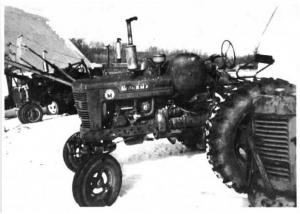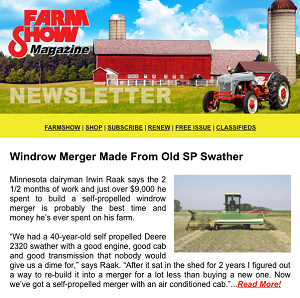He Runs His Farm On LP Gas
 ✖  |
"We haven't farmed with gasoline for more than 5 years and we probably never will again," says Edwin Hanson who runs most of his working tractors and a combine on LP gas. "We bought our first LP-powered tractor in 1974. Now all of the tractors we use regularly run on LP and so does our combine."
Some of Hanson's 15 LP tractors were converted over from gas. Others are factory originals.
"It's a lot cheaper to farm with LP. It costs about half what gasoline does," says Hanson, who raises 160 acres of corn, soy-beans, vegetables and hay with his brother Joe near Wyoming, Iowa. "If you're doing lighter work like making hay, for example, the LP tractors use about half the number of gallons of fuel a gas tractor will in a day. If you're doing heavier work, like rotary hoeing or disking, they'll use about the same amount of fuel or a little more."
What's more, because LP burns cleaner than gas, Hanson's tractors require less maintenance and repair than gas-powered models. "Gas tractors burn out valves a lot sooner than an LP tractor," he says. "When you change oil on an LP tractor you can't believe how clean it is compared to oil out of a gas tractor."
The first gas tractor Hanson and his brother converted to run on LP was a 1952 W9 International. The men first separated the one-piece intake and exhaust manifolds by cutting them apart. They rebolted the manifolds to the head, leaving a small space between them so the LP wouldn't bum too hot. They bolted a carburetor off an old International Super M underneath the opening to the tractor's air intake. They then mounted an LP tank off an old Minneapolis Moline W on the W9's drawbar and ran flexible LP hose from the tank to a regulator, which changes LP to vapor as it enters the carburetor. They also tapped into the tractor's cooling system to heat and cool the regulator and regapped plugs for a lower spark to burn the LP properly. "We didn't modify the valves or pistons in any way and we've had no problems," says Hanson
The next tractor the Hansons converted was a late 1950's Minneapolis-Moline 670. They replaced the tractor's original carburetor with one from an old Minneapolis?
Moline 5-Star LP tractor, then mounted the 5-Star's regulator on a homemade bracket just to the left of the carburetor. They readjusted the tractor's throttle linkage so the 670, which has a larger engine than the 5-Star, would get enough fuel and mounted an LP tank where the tractor's gas tank had been, ahead of the dashboard. As with the W9, they regapped plugs. "We pull a drag with it and it has plenty of power," says Hanson.
The Hansons next converted a 1950 Farmall H with a used factory conversion kit they bought from a farmer. After install¡ing the kit, they decided the regulator that came with it was too small so they installed a bigger, Century regulator.
Contact: FARM SHOW Followup, Edwin Hanson, 7602 20th Ave. Wyoming, Iowa 52362 (ph 319 488-2587).

Click here to download page story appeared in.
Click here to read entire issue
He Runs His Farm On LP Gas TRACTORS Conversions 19-2-10 "We haven't farmed with gasoline for more than 5 years and we probably never will again," says Edwin Hanson who runs most of his working tractors and a combine on LP gas. "We bought our first LP-powered tractor in 1974. Now all of the tractors we use regularly run on LP and so does our combine."
Some of Hanson's 15 LP tractors were converted over from gas. Others are factory originals.
"It's a lot cheaper to farm with LP. It costs about half what gasoline does," says Hanson, who raises 160 acres of corn, soy-beans, vegetables and hay with his brother Joe near Wyoming, Iowa. "If you're doing lighter work like making hay, for example, the LP tractors use about half the number of gallons of fuel a gas tractor will in a day. If you're doing heavier work, like rotary hoeing or disking, they'll use about the same amount of fuel or a little more."
What's more, because LP burns cleaner than gas, Hanson's tractors require less maintenance and repair than gas-powered models. "Gas tractors burn out valves a lot sooner than an LP tractor," he says. "When you change oil on an LP tractor you can't believe how clean it is compared to oil out of a gas tractor."
The first gas tractor Hanson and his brother converted to run on LP was a 1952 W9 International. The men first separated the one-piece intake and exhaust manifolds by cutting them apart. They rebolted the manifolds to the head, leaving a small space between them so the LP wouldn't bum too hot. They bolted a carburetor off an old International Super M underneath the opening to the tractor's air intake. They then mounted an LP tank off an old Minneapolis Moline W on the W9's drawbar and ran flexible LP hose from the tank to a regulator, which changes LP to vapor as it enters the carburetor. They also tapped into the tractor's cooling system to heat and cool the regulator and regapped plugs for a lower spark to burn the LP properly. "We didn't modify the valves or pistons in any way and we've had no problems," says Hanson
The next tractor the Hansons converted was a late 1950's Minneapolis-Moline 670. They replaced the tractor's original carburetor with one from an old Minneapolis?
Moline 5-Star LP tractor, then mounted the 5-Star's regulator on a homemade bracket just to the left of the carburetor. They readjusted the tractor's throttle linkage so the 670, which has a larger engine than the 5-Star, would get enough fuel and mounted an LP tank where the tractor's gas tank had been, ahead of the dashboard. As with the W9, they regapped plugs. "We pull a drag with it and it has plenty of power," says Hanson.
The Hansons next converted a 1950 Farmall H with a used factory conversion kit they bought from a farmer. After install¡ing the kit, they decided the regulator that came with it was too small so they installed a bigger, Century regulator.
Contact: FARM SHOW Followup, Edwin Hanson, 7602 20th Ave. Wyoming, Iowa 52362 (ph 319 488-2587).
To read the rest of this story, download this issue below or click
here to register with your account number.







